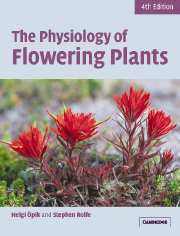Appendix
Published online by Cambridge University Press: 05 June 2012
Summary
NAMING GENES, PROTEINS AND MUTATIONS
A consistent nomenclature has been adopted for naming genes and proteins. A wild-type gene is written in italic as e.g. CRY1 (for cryptochrome) whilst mutated versions of it are written cry1. The first mutation discovered in the gene would be cry1–1, the second cry1–2, etc. In the case of cryptochrome (and many other proteins, including phytochrome) the receptor consists of a protein (the apoprotein) and a chromophore which together make the functional protein (holoprotein). The apoprotein is written as CRY1 whilst the holoprotein is written as cry1. The same mutants are often isolated by different research groups and are given different names. Once a class of genes has been relatively well studied they are sometimes renamed to avoid confusion.
UNITS OF MEASUREMENT
The system of SI units, Système International d'Unités, was introduced in 1960. In this system, the basic units of mass, length and time are the kilogram (kg), metre (m), and second (s); a number of common units, e.g. litre and hour, are abandoned. Older units, however, still abound even in current scientific literature because of their convenience (and familiarity), and some are retained in this text. Note that there is no full stop after the abbreviations, and no ‘s’ to denote the plural: thus we write 1 m and 10 m.
- Type
- Chapter
- Information
- The Physiology of Flowering Plants , pp. 373 - 375Publisher: Cambridge University PressPrint publication year: 2005



